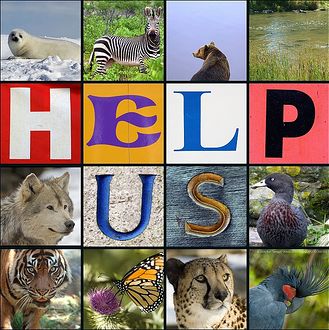
Draw Pictures - You can find out which species on the endangered species list live in your area and why they are endangered. Then draw a picture of the animal and the biggest threats to its survival. If you need a picture of the species, you can probably find one at your public library. Send the picture, along with a short letter explaining why you drew it, to your Senator or Representative. Be sure and tell them how you feel about endangered species.
Write A Letter - You can write a short letter to your U.S. Senators and Representative, the people who are in charge of the Endangered Species Act, the U.S. law that protects endangered species. Write in your own words how you feel about endangered species and when you think it is important to protect them. You can use information on our endangered species web pages for ideas. In your letter, you might select a species that is of particular interest to you and discuss why you feel so strongly about that species. Letters like yours help senators and representatives know how people in the districts they represent feel about endangered species protections.
Addresses:
To a Representative:
To a Senator:
The Honorable (name)
The Honorable (name)
U.S. House of Representatives
U.S. Senate
Washington, DC 20515
Washington, DC 20510
If your parents do not know the name of your U.S. Senators or Representative, you can call your local library to find out.
Make Masks And Costumes - Based on a picture of an endangered species, make a mask or a costume using paper mache, paper bags, construction paper, or whatever you can find around the house or in the art room at school. You can even make it a group project or a game at a party. When you finish, maybe you and your friends can wear your costumes and march in a parade. Be sure to take photographs.
Make Puppets - Find photographs from magazines or books of endangered species. From these images, create a puppet that looks like your favorite endangered animal. You can use socks, buttons, glitter, felt, orange juice cans, small bowls, plastic and aluminum wrap, glue, thread and needle, magic markers, pipe cleaners, and other odds and ends to make your puppets. Once you have made your puppet, you can create a story explaining why the species has become endangered. Use your local library and the Internet to research why the species is endangered. Using your puppet, tell your story to an audience.
Make A Storybook - Select a single, or many, endangered species that interest you. Do research in your local library and on the Internet to learn more about the species. Determine where they live and why, what they eat, what eats them, who shares their home, and why they are endangered. Draw pictures to illustrate your story. Share your storybook with others.
Personal Reading - Read and learn as much about endangered species as you can. Your local library is probably the best place to begin. You could look in encyclopedias, reference books, picture books, storybooks, magazines, and even cd-roms using a computer.
Local Species Research - Research to determine if there are any endangered species in your hometown. Try to find out what other people in your community are doing for these species. Perhaps you can interview them and ask why they are interested, and what they are doing.
Tell Others! - Share your new knowledge with others. Tell them about endangered species and explain why they are endangered. Encourage others to learn more about endangered species. Let them know that together, we can all make a difference.
Taken From: http://www.endangeredspecie.com/Ways_To_Help.htm
Here are more resources to follow to help you find more information!
http://www.worldwildlife.org/endangered/index.cfm
http://www.aboutextinction.com/prevent-extinction.php
http://wwf.worldwildlife.org/site/PageServer?pagename=can_home
http://cms.iucn.org/about/work/programmes/species/index.cfm